Digital Receipt#1
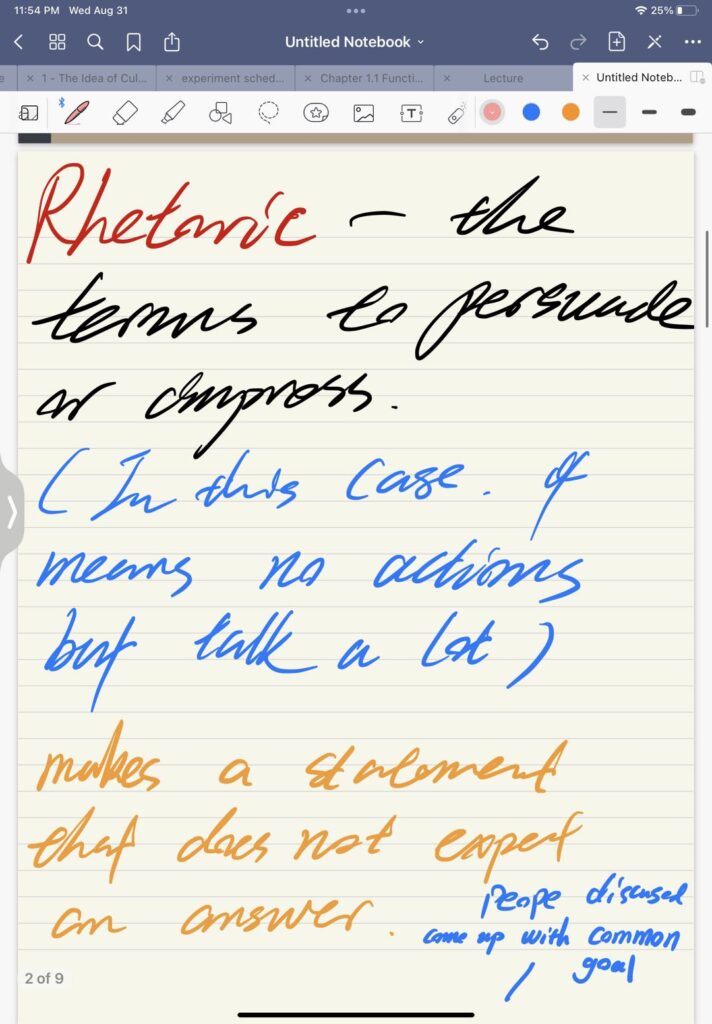
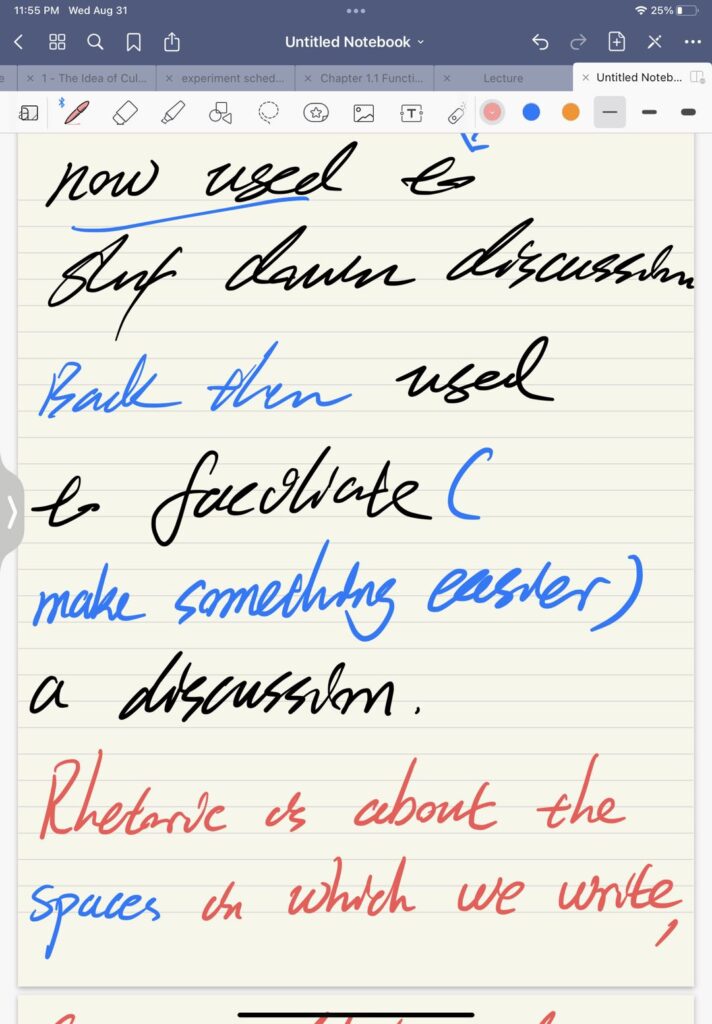
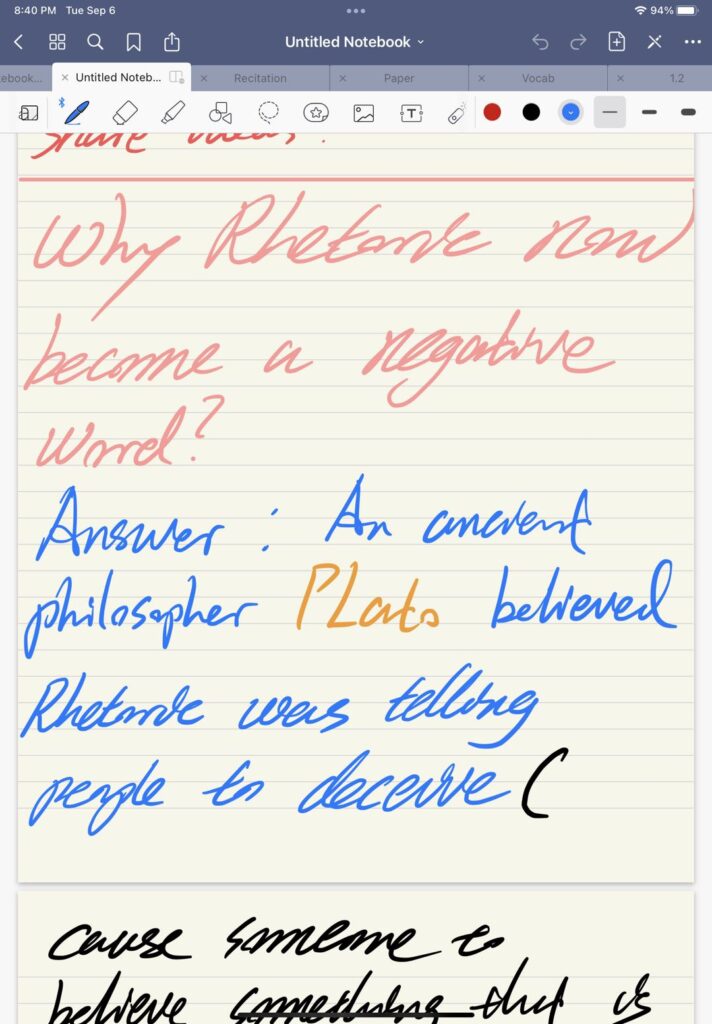

TR 2:00-3:15pm | jessericeevans@gmail.com | https://us02web.zoom.us/j/82719242667?pwd=aGlZQzR0a2p4VWhnNEM5RzZMU3ZGQT09



Backpacks vs. Briefcases by Laura Bolin Carroll talks about Rhetorical Analysis. The author starts off by opening a scenario to the reader in order to get one thinking about first impressions. She helps visualize the first day of class when our professor first walks in. The questions that come to mind, the observations we make, and the judgment that it results in. Only after reading this did I realize that I have in fact done this to my professor without even knowing it. Just in a more limited way, since we only get to meet on a zoom conference call. So, I made sure to expand my resources without knowing of course, that subconsciously I was doing this to make a fair judgment of character. The first thing I did was look up “Jesse Rice – Evans’ ‘ on Rate My Professor. That was my first step in gaining intel to draw my conclusion. I was so relieved and happy to see the rating and read the comments on what others had to say about them. That was also the first textual interpretation, the second being when I received a response from them by email. I was unaware that I was judging the language professor Evans used in the email, but they sounded enthusiastic and welcoming, further adding to my so-far favorable conclusion. I also dived into the website she had linked under her email to further gather information. Following that, I had watched the zoom recording and joined the next zoom meeting in which I had the chance to see her live. I unknowingly made good judgments off of her cute hair style, her attitude and energy. I even took into notice her background and little details such as the little avocado drawing on her wall, super cute. I drew a solid conclusion that she seemed like an amazing person who would lead an easy and enjoyable class.
From what I’ve read I can confirm we will be going over rhetoric ideas and also having to complete weekly logs based on what we read . Completing the weekly logs is very important and plays a major part in our grade. The logs help us keep track of what we’ve read and learned. At the end of the term I will be using these logs to see my performance and do an assignment. Its important to put your best foot forward when completing the digital receipts so that it’s clear that you understand the concept.
The article describes what everyone does every day: analyzing a situation or entity based on perspectives, actions, what they see visually, and what they hear; the concept itself—rhetoric analysis— is the idea of understanding/interpreting a given argument with the notion of identifying the purpose, targeted audience, and the main reason behind making the argument in the first place. There are three main parts to understanding rhetorical moments/events: exigence, audience, and constraints. Exigence is the reason why the person (who created the argument) made it this way. The audience is the target group for that said argument. Constraints are the limits of exigence; this can be any form of limitation: forcing the exigence to be that way. The ethos, pathos, and logos of an argument also help shape the structure and strength of an argument and can change the way people perceive that said argument. When looking at a statement or argument, it is best to identify these things: which will make you understand the rhetorical analysis better.
Aside from the mobile ads and online sponsorships that make you want to buy a product or item of clothing, the best example in which I analyzed a situation or person (that I can think of) was when I was paired up with a research partner in my junior year of high school. The person whom I had the option of working with had a negative/not-so-popular reputation among our class. Most of the people that knew him personally said that he could be hot-headed at times and that it was not fun to work with him; he always wanted to do things his way. The ethos of such arguments made by such individuals was not of a question as they knew him better than me, some even working with him in prior years. The exigence of these arguments might have been based on the negative experiences they may have had with him, but the constraints with that exigence would be that they had not worked with him for a while, meaning he could have changed his habits. He also could have had personal issues that they were unaware he was attending to result in such work behaviors. Despite all the warnings, I still choose to partner up with him. I found out that he was hot-headed, but not due to his lack of decency, but rather his obsession with being perfect. He set an almost impossible standard for our work, one in which everything needed to hundred percent correct at all times: being with grammar, data, statistics, formatting, and more. Using opinions that I heard from close people to judge him based on his work and how he manages to work with others, I made the wrong decision of disregarding him as a tyrant: when he was not.
Carroll’s article discussed how we practice rhetorical analysis in our daily lives without realizing it; we have also become informed consumers of rhetoric. I may have practiced rhetorical analysis while commuting to my classes without knowing. As I enter a train cart my first instinct is to look at the other commuters around me on the train. Who is standing alongside the doors in an empty train cart? Why does an individual make their way across the cart to sit in a specific spot? When analyzing the commuters on the train, I analyze how they dress and often compare their sense of style to mine. Though it might seem a bit unsettling to analyze strangers on the train, I do this as a way to pass my boredom. When comparing my style to a stranger, I first look at the color palette as a whole. Choosing to wear bright colors or a more neutral tone can inform a person about their personal interests or values. For instance, as a nature-loving person, I often wear more earthy tones such as green or brown. The conclusions that I drew based on whether someone wore a dress or a pair of jeans are influenced by social media: TikTok and Instagram. Fashion trends that are circling around the internet are always followed by assumptions about those who follow them. Whether I am fully aware of it or not, the conclusions I made, based on clothing, are a result of the social influences in the fashion industry. The way that an individual presents themselves allows me to understand the context when practicing rhetorical analysis.
A rhetorical situation that I found myself in is asking for an extension on a final paper. The framework of the situation or the exigence was the abundance of workload in other classes; therefore, making it more difficult to allocate time to spend on writing my paper. My teacher at the time was my audience and I had to develop a well-thought-out argument to support my case. Yet, there were constraints as the deadline for the paper was already discussed and students other than myself may have already finished writing the paper.
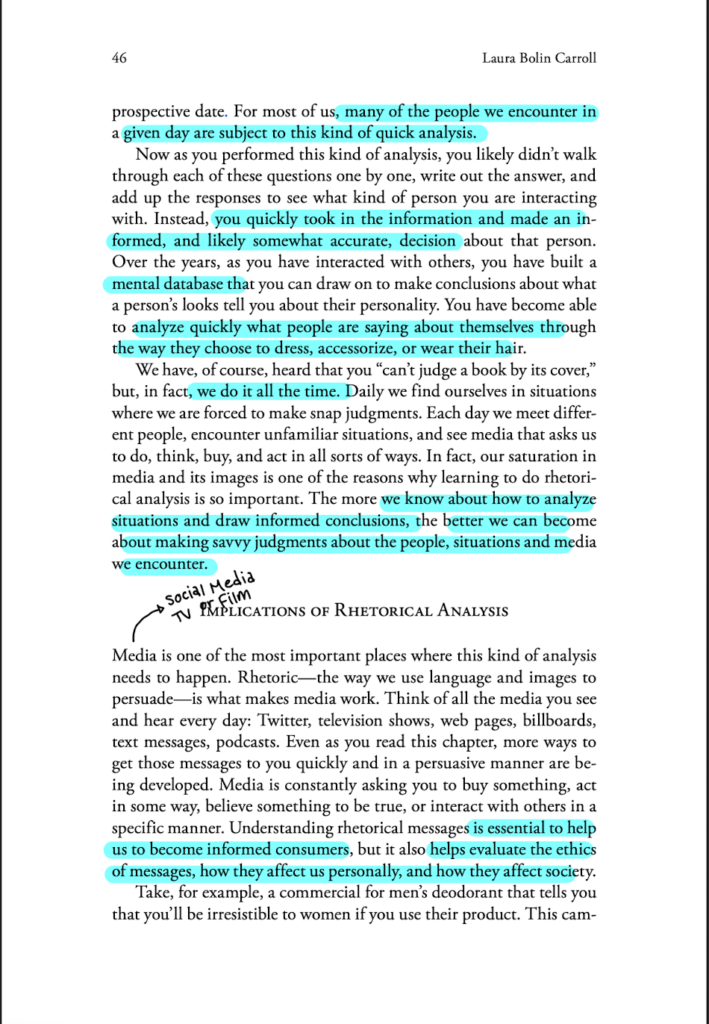
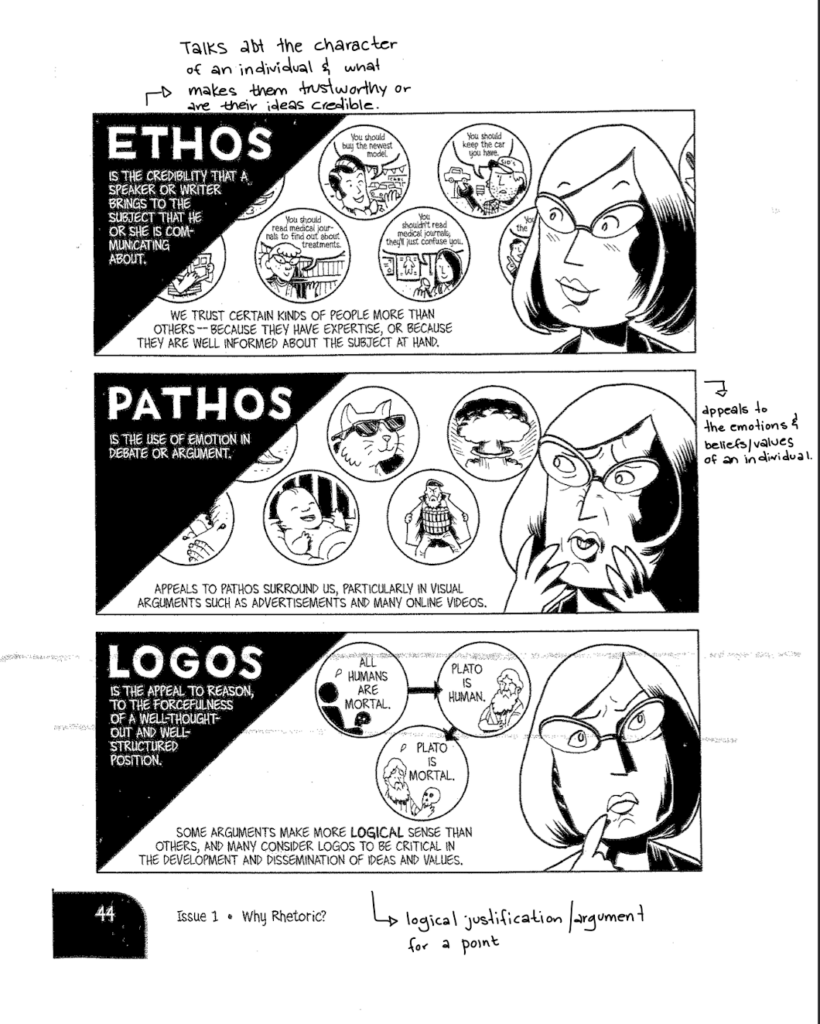
When you think of rhetorical analysis, you think of another literary skill that we’re going to have to learn to use in this class. But upon reading this article, I’ve learned that it’s prominently used throughout our everyday lives. Whether it comes from politicians and their campaigns, advocacy about environmental reforms, or from the ads we see online, rhetoric surprises us in the different shapes and forms it comes in. Rhetorical analysis is used just as often. It took me reading this article to figure out that I wasn’t the only one doing it. When we’re presented with something or someone unfamiliar, we as humans inherently try to analyze a situation before it’s fully presented to us whether we’re aware of it or not. We often do this when we’re presented with things we’re unfamiliar with like meeting someone for the first time or trying foods you’ve never tried before.

A prime example of this in my life is every time I’m about to read a book. “Don’t judge a book by its cover.” Even though this is an important principle to follow through, I often judge things based on my first impressions. So whenever I read a book, I read the title, the author, and the synopsis at the back of the book. When I was handed the book, Hamlet, I thought it’d be boring since it was written by Shakespeare but his name itself has its credibility so I gave reading the synopsis a shot. The cover page looked dramatic but it also looked like there was something more to the book than just the play. And as it turns out, the book has an amazing plot and it was worth the time to read it. I continue to use rhetorical analysis everytime I’m given the opportunity to read a book to see if it’s worth my while.
Hi all,
If you missed our Thursday meeting, you can view the recording here. One major thing we discussed was that I messed up our course meeting time. We are scheduled to meet on Tuesdays: same time, same Zoom link, just a new day. If you cannot make this time work, please contact me. I apologize for the confusion!!!!
Tomorrow I will be attending a conference, so instead of meeting synchronously, I am asking you to respond to at least two of your classmates’ responses to the Backpacks v. Briefcases reading by our next class meeting on TUESDAY SEPT 13, 2022 using the comments feature: what did you learn from this post? what questions do you have for the post’s author?
I’ve updated the course schedule to reflect this and I have added one additional short assignment:
Please closely read the WLLN assignment and make notes of your questions, concerns, and requests for resources. We will discuss this prompt in more detail on September 13, 2022. Please bring your questions with you to class that day!
Digital receipts are due this week as normal!
Thanks again everyone for your patience as we get into a regular routine!
Jesse
On a daily basis, I see and hear examples of rhetoric like ads to download other applications, mainly games, or buy items, like makeup or toys, on Instagram, and on other social media platforms, on emails that are trying to get me to sign up for an event or cause, and on streaming services to keep me watching by recommending me similar content. Also, on certain posts on social media and news sites that promote products or try to influence my personal opinion of current world issues. Some ways that I create rhetoric are how I present myself with my clothes, hair, posture, and how I act or communicate. I try to communicate how I am approachable and kind with my simple clothing and tone of voice. I also try to show that I am relaxed and a little lazy with my slumped posture. Lastly, my colored hair can show that I am a fun and bright person. An example of a rhetorical situation that I have found myself in is trying to convince my parents into letting my sister and me get a dog. The exigence is a responsibility my parents want me and my sister to take on, the issue is that they are not sure what that responsibility they want us to take on is. The audience in this rhetorical situation is my parents. They are the ones that my sister and I must convince in order to get a dog. The constraints are the fact that my parents were averse to getting a dog due to the high cost and maintenance needed to care for a dog. Another constraint was my mother’s pickiness on what kind of dog she would be okay with, not a dog too big or small and a dog that is able to protect the home.